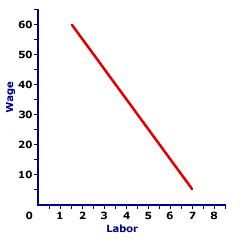
|
|
BUSINESS CYCLE PHASES: The recurring, but irregular, pattern of business cycles can be divided into two basic phases -- expansion and contraction. An expansion is a period of increasing economic activity and a contraction is a period of declining economic activity. These two phases are marked by two transitions. The transition from expansion to contraction is termed a peak and the transition from contraction to expansion is termed a trough. The early portion of an expansion is often referred to as a recovery.
Visit the GLOSS*arama
|
|


|

|
                           FACTOR DEMAND CURVE: A graphical representation of the relationship between the price to a factor of production and quantity of the factor demanded, holding all ceteris paribus factor demand determinants constant. The factor demand curve is one half of the factor market. The other half is the factor supply curve. The factor demand curve indicates the quantity of a factor demanded at alternative factor prices. While all factors of production, or scarce resources, including labor, capital, land, and entrepreneurship, have factor demand curves, labor is the factor most often analyzed. Like other demand curves, the factor demand curve is generally negatively sloped. Higher factor prices are associated with smaller quantities demanded and lower factor prices go with larger quantities demanded.For a firm that hires factors in a perfectly competitive market, factor demand curve is essentially the marginal revenue product curve. Monopsony and other imperfectly competitive firms with some degree of market control over the factor market do not have a clear-cut factor demand curve. In other words, factor price and quantity demanded may or may not be inversely related. | Factor Demand Curve |  |
The exhibit to the right displays a typical factor demand curve. This particular curve is the demand for labor by Waldo's TexMex Taco World, a hypothetical Shady Valley restaurant specializing in the production of Super Deluxe TexMex Gargantuan Tacos (with sour cream and jalapeno peppers).The number of workers is measured on the horizontal axis and the wage paid per worker is measured on the vertical axis. This factor demand curve indicates that Waldo is willing to hire 4 workers at $35 each, 5 workers at $25 each, and 6 workers at $15 each. The wage declines with an increase in the number of workers employed, because extra workers contribute less and less to total production and to total revenue. The most important feature of this factor demand curve is the negative slope. Waldo's TexMex Taco World is willing and able to pay workers a higher wage if they employ fewer workers. However, if they employ more workers, then they are willing and able to pay a lower wage. The primary reason for this inverse relation between wage and quantity demanded is the productivity of the workers and the law of diminishing marginal returns. As Waldo's TexMex Taco World employs more workers IN A GIVEN RESTAURANT, marginal product declines, each additional worker contributes less to total product as the law of diminishing marginal returns kicks in. However, with less production to sell, Waldo's TexMex Taco World generates less revenue. In other words, the law of diminishing marginal returns causes a decline in marginal physical product, and consequently a decline in marginal revenue product. But if workers generate less revenue, then Waldo's TexMex Taco World is willing and able to pay a lower wage. Because the factor demand curve, like other curves, is constructed to reflect the relationship between two variables, factor price and factor quantity demanded, changes in other variables cause the curve to shift. The three most noted curve-shifting factor demand determinants are product price, factor productivity, and prices of other factors.

Recommended Citation:FACTOR DEMAND CURVE, AmosWEB Encyclonomic WEB*pedia, http://www.AmosWEB.com, AmosWEB LLC, 2000-2025. [Accessed: July 5, 2025].
Check Out These Related Terms... | | | |
Or For A Little Background... | | | | | | | | | | |
And For Further Study... | | | | | | | | | | |
Search Again?
Back to the WEB*pedia
|



|

|
BROWN PRAGMATOX
[What's This?]
Today, you are likely to spend a great deal of time strolling through a department store hoping to buy either decorative celebrity figurines or a flower arrangement with anything but tulips for your grandfather. Be on the lookout for infected paper cuts.
Your Complete Scope
This isn't me! What am I?
|

|
|
Potato chips were invented in 1853 by a irritated chef repeatedly seeking to appease the hard to please Cornelius Vanderbilt who demanded french fried potatoes that were thinner and crisper than normal.
|

|
|
"Plans are only good intentions unless they immediately degenerate into hard work." -- Peter Drucker, management consultant
|

|
BLUE
Best Linear Unbiased Estimator
|

|
|
Tell us what you think about AmosWEB. Like what you see? Have suggestions for improvements? Let us know. Click the User Feedback link.
User Feedback
|


|


